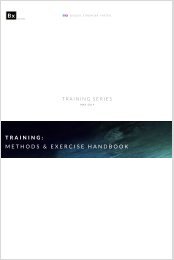Create successful ePaper yourself
Turn your PDF publications into a flip-book with our unique Google optimized e-Paper software.
HTKSPORT<br />
This may be seen, for example, as an elite sprinter who applies extreme amounts of<br />
force with a very fast stride rate, or an athlete who can change direction (decelerate)<br />
at high speed, or a boxer whose quick-fire punches pack a lot of force. DUR dominant<br />
athletes, by contrast, favour sustained neural inputs, and tend to be inefficient<br />
(relative to MAG-dominant athletes) with their motor unit recruitment and require<br />
external resistance as a stimulus for the nervous system to recruit more fibres. They<br />
may, for example, look equally strained and laboured when lifting a significantly submaximal<br />
load as they would a max lift; e.g. lift 150kg in a strained, slow manner, but<br />
also able to continue straining out reps right up to 200kg.<br />
Understanding the neural demands of various physical performances is the first<br />
fundamental to training organisation. The next few chapters will look at the various<br />
external expressions of physical performance, and how to elicit the desired neuromuscular<br />
input through movement.<br />
2.1 Muscle Strength vs. Elastic Strength<br />
Muscle strength refers to the production of force from the frictional/contractile<br />
elements of the muscle fibres; i.e. the function of actin and myosin filaments during a<br />
muscle contraction. Generally, muscular strength becomes more important the<br />
longer the duration of the movement and the heavier the resistance. Therefore the<br />
best way to develop contractile strength is through DUR-specific work. Similarly, this is<br />
why fast, explosive movements like sprints and jumps do not rely heavily on<br />
frictional/contractile strength, but rather stored elastic energy. DUR-dominant<br />
athletes will often over-rely on frictional elements to perform movements that are<br />
best performed explosively. A good example of this may be seen when comparing a<br />
completely untrained athlete who is naturally suited to sprinting (RATE/MAG<br />
dominant) with a powerlifter and comparing the relative force outputs and sprint<br />
performances. Muscle-bound athletes that are deficient in elastic qualities will rely<br />
heavily on contractile elements, which would result in them attempting to ‘muscle the<br />
track’ (typically characterised by hip, knee and ankle collapse upon ground contact<br />
and slow, bounding strides reliant on muscle contractions to move each leg with<br />
every stride – compare with top-level sprinters, who appear to effortlessly ‘float’ down<br />
the track at full speed) or lack the reactive ability to correctly perform a depth jump.<br />
13<br />
JUNE 2018 | ISSUE 01




